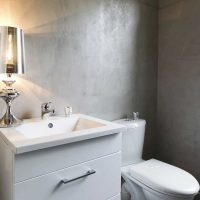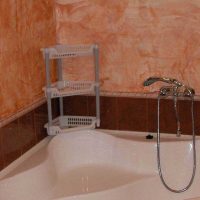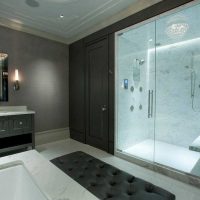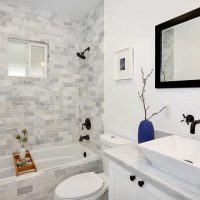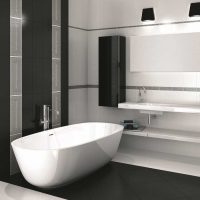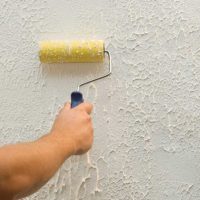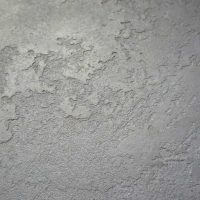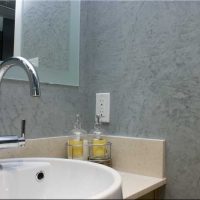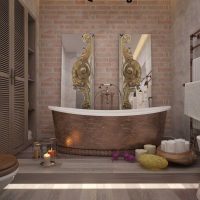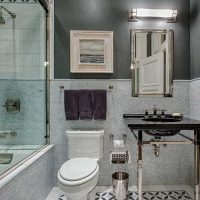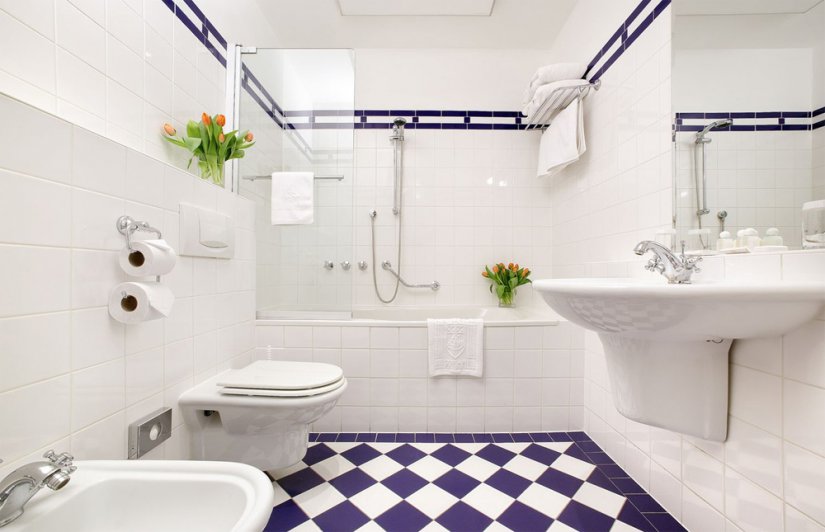Great idea for repairs - decorative plaster in the bathroom
There is an opinion that the choice of finishing materials for the bathroom is limited by plastic panels, painting and tiling. New developments annually bring to the market new moisture-resistant coatings, which have become an excellent alternative to traditional tiles. Sanitizing decorative plaster in the bathroom is one of the finishing methods that “breathes” and normalizes the microclimate of wet rooms. Some varieties require additional protection against moisture destruction, but this does not exclude plaster from the list of recommended facings for bathrooms or toilets.

Interior of the bathroom with decorative plaster and decorative brick

Wall decoration in the bathroom with decorative green stucco

The combination of mosaic tiles in the bathroom
Content
- 1 Features of bathroom plastering
- 2 What is important to know?
- 3 Advantages of decorative plaster for rooms with high humidity
- 4 Important characteristics of textured plaster for the bathroom
- 5 Recommendations for choosing decorative plaster
- 6 Video: Decorative plaster in the bathroom. Material application
- 7 50 photos of examples of using decorative plaster in a bathroom:
Features of bathroom plastering
In bathrooms and bathrooms, even with good insulation, specific conditions are created due to excess moisture. If the waterproofing is absent or not done in good faith, steam and salt deposits are eaten into the finishing materials and gradually destroy them.
The main condition is that decorative plaster in the bathroom should effectively resist dampness. Otherwise, mildew easily starts in such an environment, microorganisms develop, the fungus progresses. Modern stucco mixtures for facing rooms with high humidity contain fungicides - antifungal mixtures that block the development of harmful microflora. This is important for allergy sufferers and people sensitive to fungal mycotoxins and spores.

Decorative plaster for concrete in the interior of the bathroom

Wall decoration in the bathroom can be done with decorative plaster
There is another undoubted benefit for people who are sensitive to air quality. Textured plaster imperceptibly absorbs excess moisture and gradually gives it away while stabilizing indicators. For asthmatics and cores who find it difficult to be in a humid room, this solution may seem preferable.
Condensation does not form on the plastered cold wall, as on plastic panels and tile materials. Finishing the bathroom with decorative plaster will provide an aesthetic surface with flawless operation.
It is possible that decorative plaster will become dirty over time or will lose its original appearance during the cleaning process. This is normal for any textured surface. It can be coated with spray paint, extending the operating time. So it will be possible to delay the overhaul and update the color scheme of the bathroom or toilet.
When the plastered wall is adjacent to the bathtub or Jacuzzi, there may be doubts about the practicality of the cladding without a protective coating. All doubters can be advised of one solution - to cover part of the wall adjacent to the container with rows of porcelain stoneware, tile or artificial marble, the rest is plaster.
In those cases when the bathroom is equipped with a shower box, an oval "font" in the center of the room or a mini-pool with a podium, decorating the bathroom with decorative plaster will be ideal.

Decorative plaster is perfect for the bathroom

Wall decor made of decorative plaster
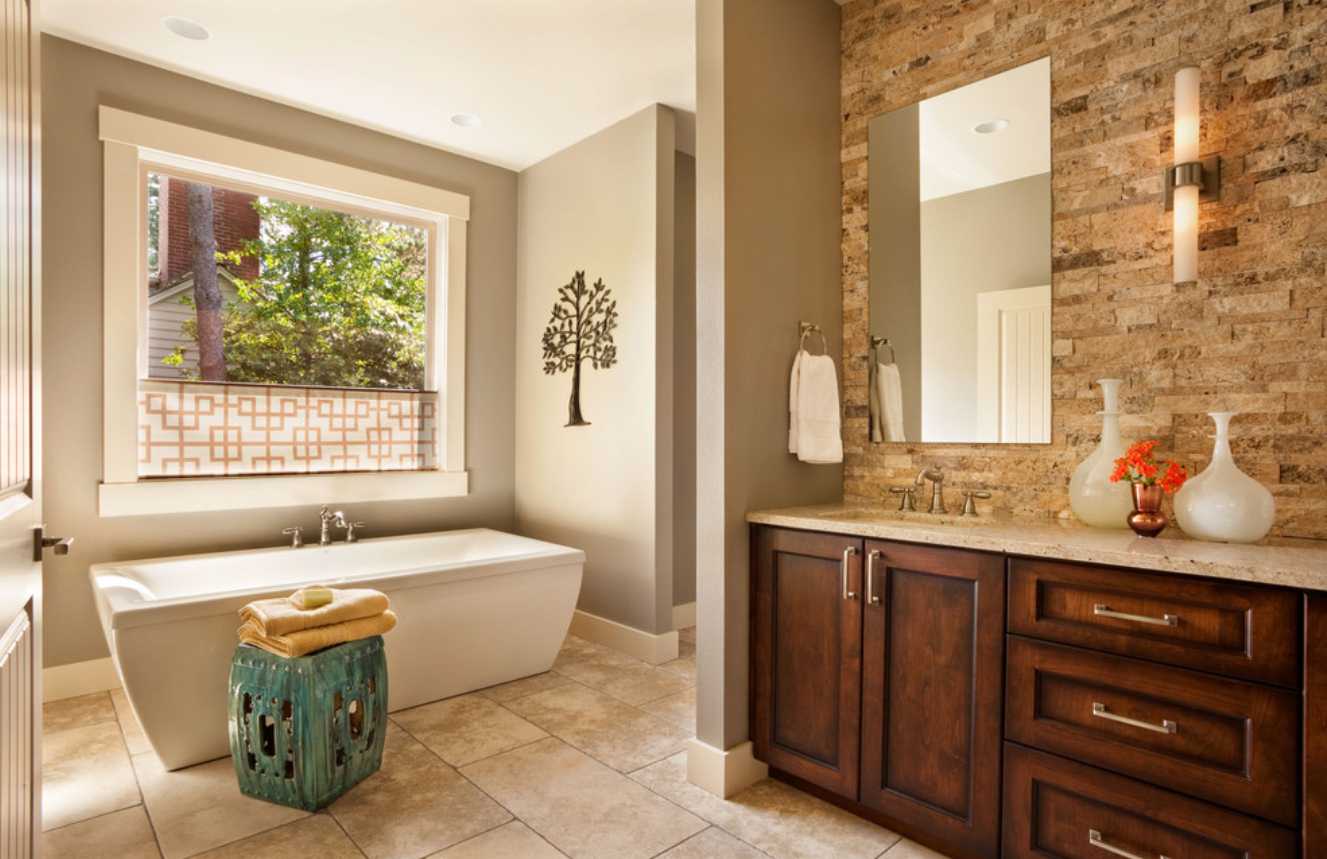
Wall decoration in the bathroom with decorative plaster
What is important to know?
A surface with a beautiful texture will become the basis of an exclusive bathroom design in a city apartment and a private house. If desired, any color can be added to the dry or prepared mixture to get the preferred shade.
If further repainting of the textured surface is planned, it is better to choose the initial tone light, then change it to a more saturated shade. For example, the light lilac color of the walls can be easily repainted in the future in pink (fuchsia), blue, purple, red or burgundy. Milk background can easily be converted into beige, golden, brown or green apple.
Remember that part of the texture may not be completely painted over, so the base will not fall out of the general palette. If you use not a spray gun, but a roller on the bark beetle plaster, you will get a two-color wall of volumetric texture.
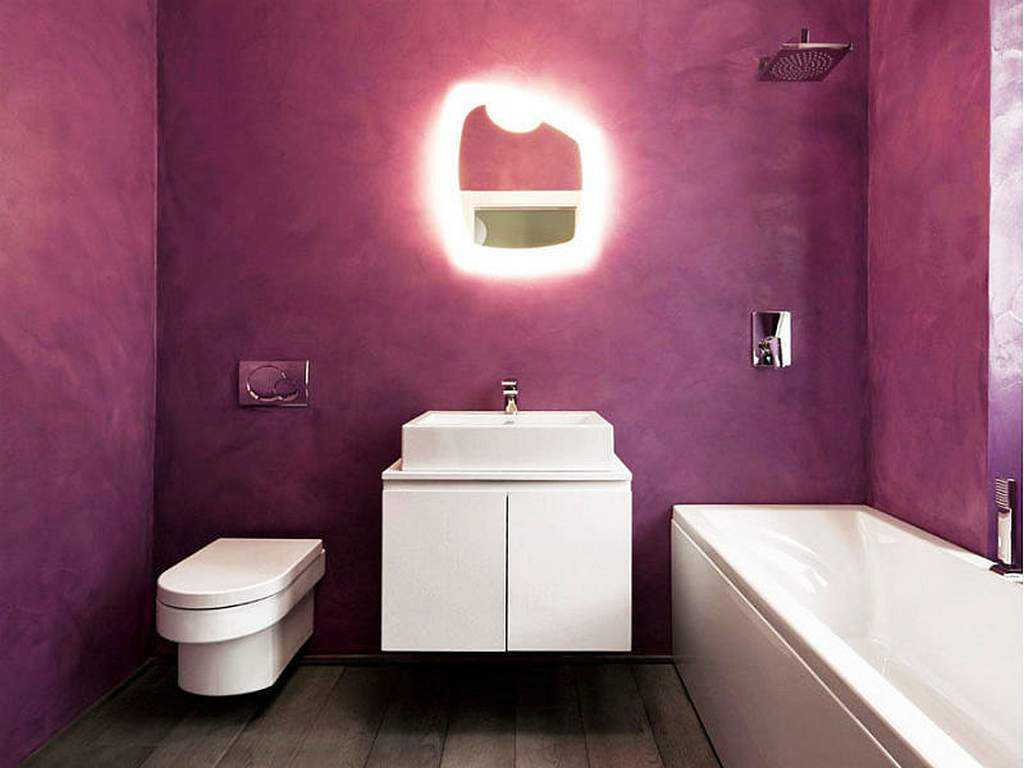
Decorative plaster comes in any color.

Flexible stone is perfect for decorating bathroom walls
In order to further protect the plaster based on a water emulsion, it is recommended to finish the dried surface upon completion of work with a wax composition or open it with a special moisture-resistant varnish. If plaster is not used on a water basis, it is not so susceptible to destruction by moisture.
The composition of most dry mixes for decorative plaster in the bathroom refers to environmentally friendly materials. They have a minimum amount of chemical additives and stabilizers that after work will be present in bound form.
An important advantage - decorative plaster for the bathroom goes well with other surfaces. It is in perfect harmony with any tiled cladding, decorative moisture-proof panels and cullets for painting. In addition, it is possible to cover surfaces with different textures with the same paint - within the framework of a single design concept.
It can also be noted that, with careful use, decorative plaster in a room with high humidity is not susceptible to contamination. It also has a simple maintenance, just walk with a brush with soapy water and pat it with a damp sponge. Abrasive cleaning mixtures are still not recommended.

Rooftop bathroom

Rust decorative plaster

Wall decoration in the bathroom with decorative plaster
Advantages of decorative plaster for rooms with high humidity
Those who decided to abandon the traditional tiled surface with its condensate and drips should remember the advantages of decorative plaster in the bathroom:
- Sufficient vapor permeability - excess moisture is absorbed and evaporates from the surface of the walls, preventing small puddles from accumulating on the floor.
- Additional protection against pathogenic and fungal microflora that develops in a humid environment.
- Minimum accumulation of condensate on mirrors, metal and polymer surfaces.
- Long-lasting impeccable finish will last a dozen years or more, later it is easy to repaint.
- Magnificent texture - a unique design of the room for hygienic procedures, relaxation and secluded relaxation.
- There is an opportunity not only to choose the textures traditional for decorative plaster, but also to “sculpt” something exclusive that cannot be repeated.
- The coating is so durable that it is difficult to remove from the wall.
- The base is not subject to destruction by ultraviolet radiation, does not support combustion and is in excellent contact with heating systems.
- The plastered surface is quite warm to the touch, maintains the set temperature for a long time even after turning off the heating.

Very unusual bathroom design

The design of the bathroom is made in chocolate color.
Finishing mixtures are applied to prepared and well prepared surfaces. If the wall does not have serious flaws, decorative plaster will hide minor defects without preliminary preparation, which will significantly reduce repair costs. This is another indisputable advantage, however, for better adhesion, you should still not refuse to work out with primer mixes on a concrete or other fairly even wall.
There are few drawbacks, but they are worth pointing out. If you need to contact professionals, such work will cost a lot. If you don’t like something, it is difficult to restructure or remove the layer with decorative plaster in the bathroom. And for working through the walls with your own hands, you need to gain some experience, since the base quickly sets, after which it is difficult to change something. It is recommended to practice on the balcony or loggia, in the toilet or pantry.

Using decorative plaster for wall decoration will be a great solution

The plaster can be applied in several layers of different colors.
Important characteristics of textured plaster for the bathroom
TABLE
|
1. |
Conditions of use |
Ventilated area, organized waterproofing, prepared base with primer, some experience and availability of tools |
|
2. |
The basis of the composition |
Acrylic, Mineral, Silicate, Gypsum |
|
3. |
Surface options |
Flokovaya, multicolor, glaze, furrowed, textured, modeling, homogeneous, Venetian (marbled), rough |
|
4. |
Manufacturers |
Ceresit (Germany), Tex-Color (Germany-RF); Terraco (Sweden), Blancolor (France), Caparol (Germany), San Marco and Oikos (Italy). |
Tip. In order to more clearly imagine this or that effect, it is better to carefully study the proposals for illustrations in the construction supermarket or specialized catalogs. The color may vary slightly, the texture will be consistent with the application technique.

Golden walls in the bathroom look very expensive

Decoration of the walls of the bathroom with decorative plaster

The entire bathroom is in green mosaic tiles
Recommendations for choosing decorative plaster
For the decoration of rooms with high humidity, not every type of finishing plaster is suitable.
Porous hydrophobic or sanitizing mixtures are used for facing different rooms:
- bathrooms;
- Bathrooms
- pools;
- basements;
- wine cellars;
- cafes and exercise rooms in the basement.
Among the smooth varieties of decorative plasters suitable for decorating bathrooms, the Venetian imitating marble is considered to be elite. The glossy surface with pearlescent overflow has a wax component that repels moisture. It looks very impressive on walls, arched vaults, columns and pilasters. You can use stencils in order to obtain three-dimensional images on top of a smooth base. The main disadvantage is the high cost and the need to contact a specialist who knows how to work in layers.
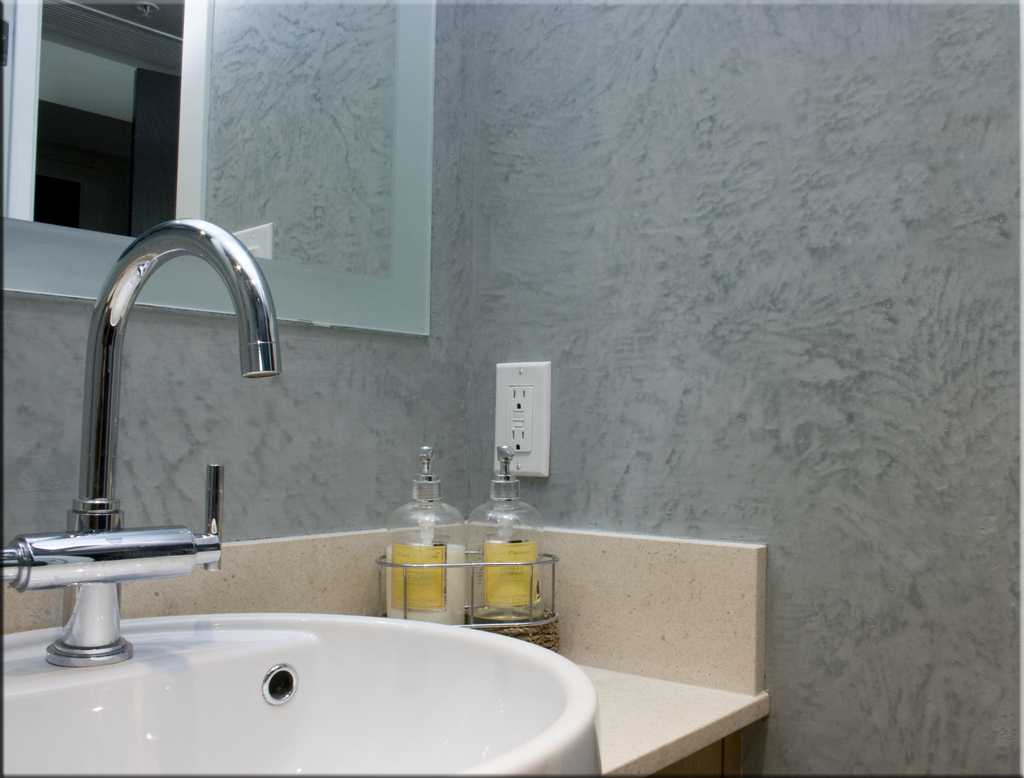
Wall decoration in the bathroom with decorative stucco for concrete

Modern style bathroom design with separate shower

Bathroom design in one color scheme
Textured or structural decorative plasters upon completion of the application process involve obtaining spectacular surfaces. The most popular is the bark beetle stucco, which is also used for interior rooms - an entrance hall, a corridor, a bathroom and a toilet. But its structure holds a lot of water, so calcium and rust stains are possible over time. To obtain a characteristic texture, add solid granules, which are displaced behind the tool, forming characteristic grooves.
Gypsum mixtures are easy to apply, solidify well and look very noble, especially in white and golden. Masters work with him not only as a basis, but also form unique three-dimensional patterns, thanks to flexibility and plasticity. It adheres well to any surface.

The design of the toilet is tasteful

The design of the bathroom is made in turquoise color
Although decorative facade mixtures are not intended for interior cladding, they are often used along with other varieties due to their strength and moisture resistance. The only “contraindication” is the presence of chemical components, therefore, after working in the next month, it is not recommended to use a small bath if you suspect an allergic reaction. But in order to be 100% sure, it is important to carefully read the recommendations and the composition indicated there.
For how to work with decorative plaster for bathrooms, see the detailed video instruction.
Video: Decorative plaster in the bathroom. Material application




